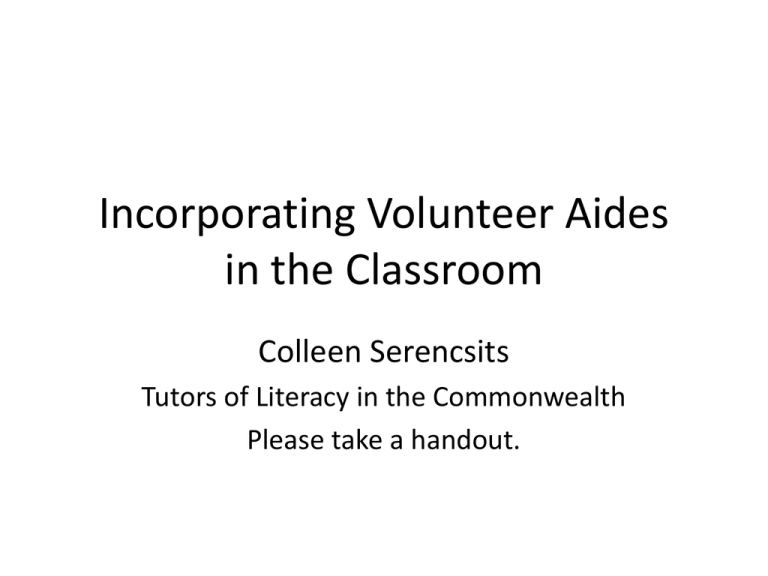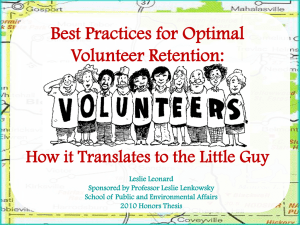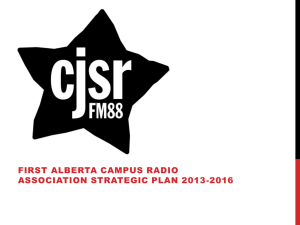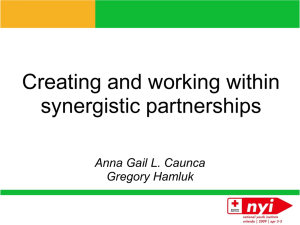Incorporating Volunteer Aides in the Classroom
advertisement

Incorporating Volunteer Aides in the Classroom Colleen Serencsits Tutors of Literacy in the Commonwealth Please take a handout. Purpose • Share information about incorporating volunteer aides in the classroom – Information to consider – How to get started – How to make the best use of volunteers Agenda • • • • • • • • • • • Volunteers in the ABE/ESL Model Benefits of Incorporating Classroom Volunteers Possible Concerns of Incorporating Classroom Volunteers Roles and Responsibilities Be Aware of Reasons Why People Volunteer Skills and Characteristics Wanted in a Classroom Volunteer Volunteer Position Descriptions Training for Classroom Volunteers Evaluation Contact Information and Resources Questions and Comments Eight Elements of the Volunteers in the ABE/ESL Model • Program Planning and Budgeting • Staff Involvement, Clarification of Staff Roles, and Staff Development • Clarifying Volunteer Roles and Responsibilities • Community Outreach and Public Image • Volunteer Recruitment • Volunteer Training and Development • Volunteer Recognition and Support: • Evaluation Eight Elements of the Volunteers in the ABE/ESL Model Each element includes the following pieces of information: • Strategy • Steps – Break into specific steps to meet each strategy. • • • • Person(s) Responsible Target Date Status Projected Costs – Estimated or actual costs. – Which items can you cover with grant funding or in-kind contributions. • Supporting Documents Benefits Incorporating Classroom Volunteers • What benefits are there to incorporating volunteers into the classroom? Benefits Incorporating Classroom Volunteers • Better meet the specific needs of learners • Teacher does not need to be everything to everyone all the time • Provide more services to students • Make multilevel classrooms more manageable • Improve program performance. – More attention, students persist, students meet goals. • Skilled volunteers may incorporate more technology. • Community members in the classroom – Raise visibility of the program. – Become advocates for the program – Increase donations Possible Concerns Incorporating Classroom Volunteers • What possible concerns or potential drawbacks are there to incorporating volunteers into the classroom? Possible Concerns Incorporating Classroom Volunteers • Require more time and work/effort – Training, management, and support – Teachers and the volunteer coordinator – Take time away from the students • Not credentialed professionals • Volunteers unreliable – Students disappointed if volunteers don’t show up • Students won’t respect the volunteer. • Teachers have no say in the process. • Teachers used to working by themselves – Not used to managing/overseeing; uncomfortable • Expensive Counteracting Concerns Incorporating Classroom Volunteers • Training time will be greatest at the beginning – Time spent will be balanced by additional support for students • Orientation, training, support to volunteers to enhance teaching skills. • Have policies, procedures, and job descriptions for the volunteer. – Attendance policies and procedures for missed classes. – If attendance is a problem, offer jobs that can be done anytime. – Recruit volunteer substitutes • Develop contracts that outline the expectations. • Survey students to find out what they think about the volunteers. – Use responses to shape requests and expectations. • Model respect for the volunteer. • Involve teachers in the process from the beginning. • Provide training and support to teachers in working with volunteers. Roles and Responsibilities • Program Director – Responsible for the entire ABE/ESL program • Program Coordinator – Responsible for instructional services within the program • Volunteer Coordinator – Responsible for managing the volunteer component • Teacher – Responsible for the classroom and instruction • Volunteer • Students Roles and Responsibilities • Program Director – Makes the decision about whether or not to have a volunteer component. – Approves budget and staff responsibilities. – Evaluates the impact of using volunteers. – Ensures teachers have a voice in decision-making about the volunteers in the classrooms. – Helps to make the volunteer feel a valued part of the organization. Roles and Responsibilities • Program Coordinator – Supervises teachers; provides support to teachers. – Ensures teachers have a voice in decision-making about the volunteers in the classrooms. – Provides a space for volunteers. – Helps to make the volunteer feel a valued part of the organization. Roles and Responsibilities • Volunteer Coordinator – Recruits, trains, and places volunteers. – Invites potential volunteers to observe a class. – Suggests additional training to the volunteer. – Provides support to teachers. – Resolves issues that arise with volunteers. – Provides overall volunteer recognition. – Maintains records on volunteer hours / activities. – Helps to make the volunteer feel a valued part of the organization. Roles and Responsibilities • Teacher: Roles and Responsibilities • Teacher: – Chooses what to teach in the classroom, and how to teach it. – Meets with the volunteer; communicates periodically. – Provides clear and explicit instruction to the volunteers of the expectations, routines, and procedures of the classroom, and specifically what is expected of them. Doesn’t assume anything. – Introduces the volunteer to the students and other volunteers. – Models respect for the volunteer. – Coaches, manages and supervises the day-to-day work of the volunteers in the classroom. – Is a role model for volunteers in how to work with learners. – Provides meaningful tasks for the volunteer to do in the classroom. Roles and Responsibilities • Teacher: – Is aware of training and support that volunteers receive; suggests additional training. – Provides on-the-job training as needed. – Provides feedback to the volunteer. Is open to suggestions from the volunteer. – Reports volunteer activity (records, concerns, ideas) to the volunteer coordinator. – Ask for comments from the students about their work with the volunteers. – Keep volunteer informed of progress made by the learners – Provides individual volunteer recognition. – Helps to make the volunteers feel a valued part of the organization. Roles and Responsibilities • Volunteer Roles and Responsibilities • Volunteer: – Works with individual students or small groups of students in the classroom or nearby, at the direction of the teacher. – Maintains confidentiality with respect to the learners and the program. – Maintains appropriate contact with the students. – Chooses the best methods to accomplish a particular task. – Informs staff of additional training that would be useful. – Models appropriate behavior to the students. – Respects and adheres to school policies and procedures. – Learns and follows classroom behavior expectations and management strategies. – Notifies the teacher privately of any student concerns. – Arrives when expected, or contacts program. – Is flexible, enthusiastic, and creative. Roles and Responsibilities • Students – Show respect for the volunteers, the teachers, and others in the program. – Provide feedback when asked, or if there are concerns. Skills Wanted Classroom Volunteer What skills do you want in a classroom volunteer? Skills Wanted Classroom Volunteer • • • • • Communication Skills People Skills Reading, Writing, and Numeracy Skills Multitasking and Organizational Skills Leadership Skills Personal Characteristics Wanted Classroom Volunteer What personal characteristics do you want in a classroom volunteer? Personal Characteristics Wanted Classroom Volunteer • • • • • • • • • • • • Interest in working with adult learners Interest in meeting and working with people of other cultures. Ability to relate to and empathize with the students Able to make a regular commitment in the times you have classes Motivation to help others Reliability Ability to see where help is needed and step in to help Speak English fluently and correctly Ability to praise and offer encouragement – Realize that praise and encouragement go a lot further than criticism. Ability to promote a positive learning climate and secure environment where students feel comfortable. Model the characteristics of a life-long learner Teaching experience may be beneficial, but is not required. Division Requirements • Volunteer tutors/instructors work one-on-one or in small groups with learners. – The Division has specific requirements for tutors/ instructors. • Classroom aides are volunteers who provide supplementary instruction in a managed or open entry / open exit class, under the supervision of a teacher. – The Division does not have specific requirements for classroom aides. Volunteer Position Descriptions • Define roles and responsibilities. – Staff, current volunteers and potential volunteers will have a clear understanding of expectations from the beginning of the experience. – See the sample position description later in the handout. How Can I Use Volunteers? • Ask yourself these questions: – What student needs are not being met? – What would I like to try during instructional time, but don’t have the time or skills to accomplish? – What kind of help would I like during instructional time? – What does my program ask of me that is difficult for me to provide alone? – What do I do that someone else could do? How Can I Use Volunteers? My Dream List • List the tasks that you would like to see happening in your classroom, that are not currently happening. • What skills would be needed to perform these tasks? Possible Roles for Classroom Volunteers • Instructional Roles • Non-Instructional Roles Possible Roles for Classroom Volunteers Instructional Roles • Tutor one-to-one with a student. • Work with small groups of students, usually all at the same level. Possible Roles for Classroom Volunteers Instructional Roles • Work with small groups of students, usually all at the same level. – – – – – – – – – – Provide individualized instruction. Provide more explanation for teacher’s instruction. Provide extra guided practice. Adapt work to preferred learning style. Adapt work for students with learning differences. Partner read, or read to students. Help with routine practice, such as vocabulary or math flashcards. Review homework assignments. Ask questions after students have read a story monitor comprehension. Help students complete graphic organizers to help students monitor comprehension. – Help students prepare for writing activities: brainstorming or creating concept maps. – Review and edit writing assignments with the students. Possible Roles for Classroom Volunteers Instructional Roles • Teach short segments of class. • Practice conversation skills with ESL students. • Act as role-playing partner. • Facilitate group discussions. • Translate, either a word/phrase as needed, or more lengthy conversations. • Instruct and assist students using computers. • Help students who have been absent to catch up. • Videotape learners in role-playing job interviews; provide feedback. • Videotape learners reading; provide feedback on fluency. • Point out the relevance of instruction to students’ lives. • Perform whatever tasks teacher requests, or volunteer sees are needed. • Provide specific praise and encouragement. Possible Roles for Classroom Volunteers • Non-Instructional Roles Possible Roles for Classroom Volunteers Non-Instructional Roles • Speak on special topics, such as technology, community resources, nutrition. • Develop materials: picture files, worksheets, questions for reading passages, flashcards. • Prepare materials for homework or take-home activities. • Plan or conduct field trips. • Search for and gather information useful in class activities. • Develop, set up, and/or monitor and assist at learning centers for particular topics. • Replace materials at learning centers. • Find, develop and/or set up games to practice particular topics. • Search for videos on particular topics. • Correct worksheets, tests, writing assignments. • Organize classroom materials, such as workbooks and manipulatives. • Assist with student intake and orientation. • Assist with pre- and post-testing. • Maintain records, portfolios; take and track attendance. • Prepare reports of work completed and materials used. • Make copies, laminate; generally help with class preparation. Be Aware of Reasons Why People Volunteer Why do people volunteer to help in an ABE or ESL or GED classroom? Be Aware of Reasons Why People Volunteer People volunteer in adult ESL programs for many reasons: • To meet new people • To learn about different cultures • To acquire training or work experience • To become involved in the community • To welcome newcomers to the community • To give something back to society • To fulfill school or university requirements • Grew up in a household where English was not the primary language. Provide volunteer experiences that match the reasons the person volunteered. Training for Classroom Volunteers • Orientation to the program and the volunteer’s place within the program • Introduction to staff • Introduction to the procedures and processes of the classroom – Tour of the classroom – Copy of the classroom schedule or regular routine – Introduction to and location of materials – Chance to ask questions • Information about adult learner characteristics and instruction • Planning a lesson (if the volunteer will be presenting lessons) • Volunteer schedules and reporting hours • Help volunteers to feel welcome and comfortable in the classroom. Training for Classroom Volunteers In-service opportunities for volunteers • Include in regular staff development activities • Separate training • A handbook with general tips for the volunteer tutor • Regular in-service opportunities determined through needs assessment • Newsletter for volunteers with teaching tips and information about program • Networking sessions with volunteers in other classes Management • Mismatches should be brought to the attention of the volunteer coordinator by the teacher or by the volunteer. – Volunteer and Teacher – Volunteer and Class level Evaluation • Collect Data • Match the evaluation to what the classroom volunteer program accomplishes. Evaluation Collect Data • Document the amount of time that volunteers work with students. – The teacher might collect and compile hours. – The volunteers might compile and submit hours. – The volunteers might sign in and sign out. Evaluation Match the evaluation to what the volunteer program accomplishes. • More one-on-one instruction for lower-level students. – Document hours of one-on-one instruction provided to each student. – Document the number of students who received at least 15 minutes of oneon-one instruction each session. • Student assessment – Track the number of students pre- and post-tested each month. – Track the results of students post-tested. • Note more subjective changes. – – – – Changes in attitudes and behaviors Quality of the experience for teachers. Quality of the experience for volunteers Quality of the experience for students. Evaluation Evaluation for Continuous Improvement • Provide formative, ongoing feedback to volunteers. – Self-evaluation form for volunteers to complete – Classroom observations – Formal external evaluation of performance. • Ask for feedback from volunteers. • Evaluate your program at least annually to determine strengths and areas in need of development. – Provide exit interviews and annual surveys asking for volunteers’ input. – Conduct a retreat of volunteers and staff to get ideas for improvement. • Review and modify your volunteer program’s strategic plan. • Ask another local program to conduct an evaluation of your program. – Peer review is an inexpensive way for two programs to help one another. Other Useful Hints Refer to the master handout for Volunteers Make a Difference for information about job descriptions recruiting managing / coaching and other information Resources Online Courses • Professional Studies AE – Creating a Volunteer Program in the ABE/ESL Classroom – Using Volunteers in Your Adult Education Classroom • ProLiteracy EdNet – – – – – – Creating a Volunteer Program in the ABE/ESL Classroom Meeting the Needs of Volunteer Tutors Some Questions to Ask When Interviewing for a Volunteer Literacy Position Using Volunteers in Your Adult Education Classroom Valuing Volunteers: Effective Methods of Retaining Today’s Volunteers Volunteers Are Vital: Incorporating Volunteers into Your Program’s Future • Basics of Adult Literacy Education OVAE – Module 5 - Adult Literacy Classroom Instructional Design Resources • Information Conclusion • Volunteers choose whether or not to volunteer. – Like adult learners, they need to feel welcome and comfortable in classroom. • Volunteers are seldom paid; not because they are worthless, but because they are PRICELESS! • Don’t give up. – If you’re just starting to use volunteers it will take time to get a program in place and show formal student gains. – Meanwhile, look for informal favorable comments to encourage all involved. • Don’t try to do it alone. – Look at programs that successfully use volunteers and build on what they have developed. – Look at ProLiteracy and sources for information and sample templates. Conclusion • What questions or comments do you have? Thank you for your participation. Please contact TLC if you would like electronic copies or more information. colleen@tlcliteracy.org www.tlcliteracy.org 814-867-0203




